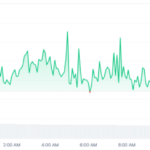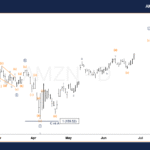- Mexican Peso nosedives on robust US data, USD/MXN clears 20.00.
- Peso faces additional pressure from former President Trump’s tariff threat on Mexican-made cars, triggering a sell-off.
- IMF lowers Mexico’s 2024 growth forecast to 1.5%, highlighting a deeper slowdown and rising inflation risks.
The Mexican Peso remains on the defensive, posting four days of losses against the Greenback. US Retail Sales and jobs data fared better than economists expected, bolstering the US Dollar. At the time of writing, the USD/MXN trades at 19.92, above its opening price by 0.28%.
Earlier, during the North American session, the USD/MXN cleared the psychological 20.00 figure after the US Department of Commerce revealed solid Retail Sales in September. At the same time, the US Department of Labor announced last week that the number of Americans filing for unemployment benefits was below projections.
After the data, the buck extended its gains, as shown by the US Dollar Index (DXY). The DXY, which tracks the American currency against another six, gains 0.26% to 103.80, slightly above the 200-day Simple Moving Average (SMA) of 103.77.
Despite that, the US Federal Reserve (Fed) is heavily expected to lower interest rates by 25 basis points at the November meeting. Odds remained at 90.9%, according to the CME FedWatch Tool data.
Recently released data showed that US Industrial Production tumbled, blamed on the Boeing strike and two hurricanes.
Across the south of the border, Mexico’s economic docket remained absent. However, former President Donald Trump’s announcement that he would impose a 200% tariff on cars manufactured in Mexico once he wins the election triggered a Peso sell-off.
In its latest report, the International Monetary Fund (IMF) projected the Mexican economy to grow 1.5% in 2024, lower than in its previous forecast. The IMF estimates a deeper economic slowdown for the next year, estimating 1.3% GDP growth, and foresees inflation moving toward the Bank of Mexico’s (Banxico)3% goal.
Further US data will be revealed on Friday. Building Permits, Housing Starts and Fed speakers could dictate the direction of the USD/MXN.
Daily digest market movers: Mexican Peso tumbles as USD/MXN surges past 19.90
- Earlier during the North American session, the Mexican Peso touched a five-week low as the USD/MXN hit a high of 20.02
- The IMF said that a recent judicial reform creates “important uncertainties about the effectiveness of contract enforcement and the predictability of the rule of law.”
- Banxico’s survey revealed that economists estimate the central bank will lower rates by 50 bps for the rest of the year. The USD/MXN exchange rate is projected to end at 19.69, and the economy is expected to grow by 1.45% in 2024.
- September US Retail Sales rose by 0.4% MoM, above estimates of 0.3% and August’s 0.1% increase.
- Initial Jobless Claims for the week ending October 12 came at 241K, below estimates and last week’s 258K.
- US Industrial Production in September contracted -0.3% MoM from 0.3% growth due to external factors.
- Data from the Chicago Board of Trade via the December fed funds rate futures contract shows investors estimate 48 bps of Fed easing by the end of the year.
USD/MXN technical outlook: Mexican Peso plummets after USD/MXN pierced 20.00
The USD/MXN uptrend remains in play and hit a two-month high above 20.00. The Relative Strength Index (RSI) suggests that bulls are in charge, which could pave the way for further upside.
If USD/MXN clears the 20.02 high of October 17, the next stop would be the YTD high at 20.22. On further strength, a rally to 20.50 is on the cards.
Conversely, if the USD/MXN tumbles below the October 1 high turned support at 19.82, it could exacerbate a test of the October 10 daily peak at 19.61. On further weakness, the next floor will be the October 4 swing low of 19.10 before testing 19.00.

Banxico FAQs
The Bank of Mexico, also known as Banxico, is the country’s central bank. Its mission is to preserve the value of Mexico’s currency, the Mexican Peso (MXN), and to set the monetary policy. To this end, its main objective is to maintain low and stable inflation within target levels – at or close to its target of 3%, the midpoint in a tolerance band of between 2% and 4%.
The main tool of the Banxico to guide monetary policy is by setting interest rates. When inflation is above target, the bank will attempt to tame it by raising rates, making it more expensive for households and businesses to borrow money and thus cooling the economy. Higher interest rates are generally positive for the Mexican Peso (MXN) as they lead to higher yields, making the country a more attractive place for investors. On the contrary, lower interest rates tend to weaken MXN. The rate differential with the USD, or how the Banxico is expected to set interest rates compared with the US Federal Reserve (Fed), is a key factor.
Banxico meets eight times a year, and its monetary policy is greatly influenced by decisions of the US Federal Reserve (Fed). Therefore, the central bank’s decision-making committee usually gathers a week after the Fed. In doing so, Banxico reacts and sometimes anticipates monetary policy measures set by the Federal Reserve. For example, after the Covid-19 pandemic, before the Fed raised rates, Banxico did it first in an attempt to diminish the chances of a substantial depreciation of the Mexican Peso (MXN) and to prevent capital outflows that could destabilize the country.






